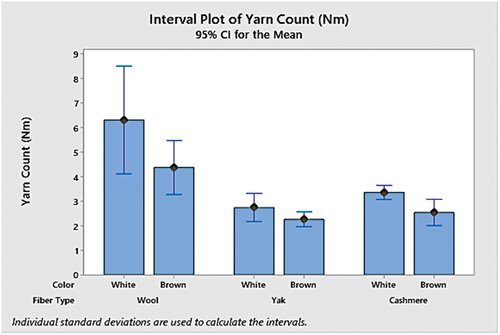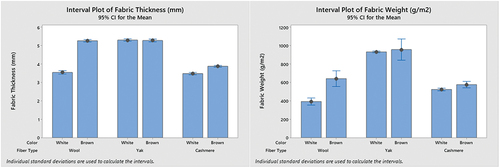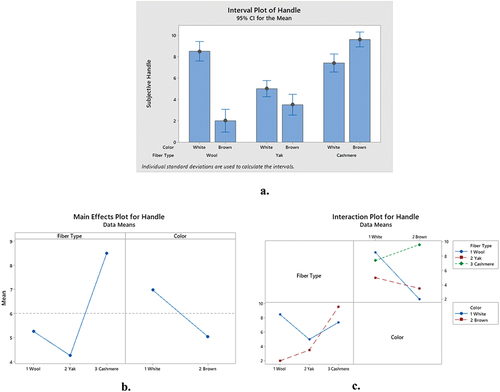 ?Mathematical formulae have been encoded as MathML and are displayed in this HTML version using MathJax in order to improve their display. Uncheck the box to turn MathJax off. This feature requires Javascript. Click on a formula to zoom.
?Mathematical formulae have been encoded as MathML and are displayed in this HTML version using MathJax in order to improve their display. Uncheck the box to turn MathJax off. This feature requires Javascript. Click on a formula to zoom.ABSTRACT
Luxury fibers are used for their tactile properties, comfortable feeling for the users, and sometimes for status in society. These fibers are all protein-based and have always been compared to the properties of wool. Cashmere is known for its incredibly soft and warm yet lightweight and breathable qualities, making it a must-have fabric for any fall and winter closet. Besides labored and time-wasting cashmere production makes the fiber very expensive. Yak fiber is an alternative to expensive cashmere with similar properties, which costs only a quarter of cashmere. In this study, air and water vapor permeability properties, which are important for consumer comfort were investigated in addition to handle properties of the fabrics compared with the properties of the fabrics made of wool fibers. It was found that yarns made of wool fibers were easy to spin in fine yarn counts whereas yarns made of yak fibers were the coarsest. Hand-knitted fabrics made of cashmere fibers had the softest feeling even if the fabrics were produced with similar technical specifications. The permeability results of the fabrics were different, especially the porosity of the fabrics had a higher impact on the permeability of the fabrics.
摘要
奢侈纤维被用于其触觉特性、使用者的舒适感,有时还用于社会地位. 这些纤维都是以蛋白质为基础的,一直被拿来与羊毛的性能进行比较. 羊绒以其令人难以置信的柔软、温暖、轻盈透气的品质而闻名,是秋冬衣橱的必备面料. 除此之外,羊绒的生产既费力又浪费时间,这使得纤维非常昂贵. 牦牛纤维是昂贵羊绒的替代品,具有类似的性能,而昂贵羊绒的价格仅为羊绒的四分之一. 在这项研究中,除了研究织物的处理性能外,还研究了对消费者舒适性很重要的透气性和水蒸气渗透性,并将其与羊毛纤维织物的性能进行了比较. 研究发现,羊毛纤维制成的纱线很容易纺成细纱线,而牦牛纤维制成的纱最粗. 由羊绒纤维制成的手工针织织物即使生产的织物具有类似的技术规格,也具有最柔软的感觉. 织物的渗透性结果各不相同,尤其是织物的孔隙率对织物的透气性影响较大.
Introduction
Natural fibers get attention due to their sustainability, being environmentally friendly, and comfort feelings in terms of consumers’ perspectives. Wool is a unique fiber that has a bicomponent structure of a side-by-side configuration of ortho and paracortex. This structure gives the fiber crimp which results in high comfort for the consumer. Besides having a bicomponent structure, wool has specific surface geometry. There are overlapping scales called cuticle cells on the outer surface of the wool, which have a waxy coating, making wool water repellent but still allowing absorption of water vapor. These cuticle cells have the ability to feel. The ability to absorb moisture into the fiber makes the products produced from these fibers provide heat transfer (Wool Fibre Properties, Citation2022). These countless properties make wool fibers unique and there is a search for substituting these fibers with other protein fibers.
Animal fibers, such as mohair, angora, cashmere, alpaca, camel hair, and vicuna are not only very expensive, but also make them very attractive due to the reasons, such as the availability of raw material resources in a very narrow specific regions, low amounts of production, and the possibility of obtaining extremely soft, bright, and stylish fabrics (Atav Citation2009). Although these luxury fibers belong to the same family with wool fibers and show similar characteristics, they have been compared with wool fibers as a criterion. Cashmere goats (Capra hircus Laniger) living in the high and dry plateaus from northern China to Mongolia, including the Gobi Desert, are known as “shawl goats” or “Tibetan goats.” These goats have one protective outer coat consisting of coarse fibers and one downy undercoat consisting of fine and soft fibers. The Kashmir goats of China and Mongolia yield fiber with diameters ranging from 14.5 to 16.5 µm; that of Iranian goats is 17.5 to 19.5 µm. Color, usually gray or tan, varies from white to black (Cashmere, Citation2022). These fibers have diameters finer than those of the best wools.
The yak (Poephagus grunniens), the lifeline of highlanders, is one of the larger members of the bovine family living in the high altitudes of the Himalayas (Das et al. Citation2017). Yak animals are special and precious for the Himalayan people in terms of milk, meat, mounting, leather, and its unique fiber. Guard hair which is greater than 50 microns in diameter and is the most found in the animal, mid-layer which is usually between 25 and 50 microns in diameter and down hair which is 20 microns in diameter are specifically produced from the yak (Das et al. Citation2017). The guard hair is strong, coarse in texture and is traditionally used by nomads to make ropes, extremely warm blankets, and for nomadic tents. The mid-layer has the potential to be spun into yarn but despite having a good strength, it is only suitable in the form of outwear fabric as it is uncomfortable to wear. The down hair is the softest of all fibers however, the yield of down fiber is very low about 400 gms thus making it more expensive. The down fiber is a particular attribute of the winter coat of the yak as an additional layer of insulation underneath the coarse hair. Yak fiber resembles to cashmere fibers in terms of physical characteristics and morphological properties which were also examined in many studies (Liu, Xie, and Liu Citation2018). Therefore, this makes them be used instead of cashmere fibers which are four times more expensive. However, it is difficult to distinguish yak and cashmere fibers even for experts especially after bleaching processes. Many studies were about developing a new technique to distinguish yak fibers from cashmere and also cashmere fibers from wool fibers (Angelow et al. Citation2016; Kim, Kim, and Choi Citation2013; Lu et al. Citation2013; Paolella et al. Citation2013; Vineis et al. Citation2014; Vineis, Aluigi, and Tonin Citation2011; Xing et al. Citation2019, Citation2022; Yuan, Lu, and Zhong Citation2016; Zoccola et al. Citation2013). Apart from fiber identification studies, there are also lots of studies including cashmere fiber processing, blending these fibers with wool or other fibers and the properties of the produced fabrics made of cashmere fibers especially pilling properties. McGregor and Postle (Citation2004) studied the properties of the cashmere tops and also cashmere/wool blended superfine low crimp tops and found that blending cashmere with wool obtained similar characteristics like pure cashmere tops. Raja et al. (Citation2011) investigated the possibility of producing pure cashmere shawl fabric using machine spun yarns since it is diffucult to spin cashmere fibers into yarns because of their soft, short and slippery scales. Li and Zhou (Citation2006) investigated the parameters affecting the pilling properties of cashmere knitted fabrics and found that cashmere fibers less than particularly 7.5 mm were responsible for pilling. Li, Jia, and Zhou (Citation2009) studied the effect of yarn properties on the pilling of cashmere knitted fabrics and revealed that yarn twist and especially the dyeing process in which cashmere fiber dye color affected the pilling property. McGregor and Postle (Citation2015) investigated the mechanical properties of cashmere single jersey knitted fabrics blended with high and low crimp superfine merino wool and concluded that adding cashmere to wool increased the fabric softness, smoothness, flexibility and suppleness. Comfort properties of cashmere and cashmere/wool blended fabrics were also investigated (McGregor and Naebe Citation2016; Naebe and McGregor Citation2013). The production of 100% yak spun yarns by means of a special hollow roller made of stainless steel with a strip groove structure on its surface were studied and the results were compared with those of the ones produced with conventional ring spinning (Li et al. Citation2016). Handle properties of unbleached and bleached knitted fabrics were investigated in a study by means of the FAST system and an improved process for a better handle and less fiber damage was suggested as a result of the study (Yan, Höcker, and Schaefer Citation2000). Properties of knitted fabrics made of yak and cotton-blended yarns were investigated, and it was found that increasing the cotton ratio in the blend improved all the results of the fabric properties (Qin et al. Citation2017).
All these studies mentioned above included only cashmere fibers in comparison with wool or only yak fibers in comparison to wool. However, there are a few studies including both cashmere and yak fibers and the fabrics made of these fibers at the same time to the best of authors’ knowledge. Atav, Ergünay, and Gurkan Unal (Citation2022) studied the effects of pigmentation on the physical and mechanical properties of cashmere and yak down fibers. Although the diameter of the colored fibers was higher, tenacity, and elongation values were lower compared to the ones of white equivalents, they concluded that the colored fibers could also be used in the textile industry with less dyeing process, which makes them environmentally friendly. Properties of yak fibers in comparison to cashmere and camel fibers were investigated, and it was found that yak wool was thickest and shortest, while cashmere was the thinnest and a little shorter than camel (Liu, Xie, and Liu Citation2018). Qin and Qu (Citation2022) investigated the possibility of yak fiber spinning and its properties with comparison to colored cashmere, camel hair, and mohair fibers. As a result of the study, it was found that the compositions of yak cashmere and cashmere were similar, and made the physical properties of yak and cashmere fibers similar. Comparing with the mohair, camel hair and cashmere fiber, the average length of yak cashmere was smaller and the length distribution is larger, and the distribution of yak cashmere strength was larger, which made the yarn spinning of yak fiber difficult, especially the high count pure yarn.
The importance of the study is to distinguish between fabrics whether they are made of yak or cashmere fiber. Since these two fibers have similar structures even difficult to distinguish them under a microscope, especially after the bleaching process, which causes yak fibers to be used in the clothing industry instead of cashmere fibers because of the relatively cheap prices of yak fibers. This study aims to show whether the results of the fabrics made of yak and cashmere differ significantly. Cashmere and yak fibers are found in various colors in nature as it was indicated in the introduction part. Furthermore, the effect of fiber pigmentation on the properties of the fabrics was investigated.
Materials and methods
In this study, plain hand-knitted fabrics were produced from sheep wool fibers, yak down fibers and cashmere down fibers in white and brown colors. Cashmere and wool fibers were kindly supplied from Yünsa Inc.-Turkey while yak fibers were supplied from local farms in Mongolia. Since the fibers supplied for the study were not enough for industrial production, both yarns and fabrics were produced by hand-production. Hand-spun yarns were produced with the help of a spinner by one villager who was an expert. After the yarn production stage, the hand-spun yarns were knitted into fabrics by the same person. For the spinning and knitting stages, the same person was used to decrease the variation of the different person’s effect.
After yarn spinning and knitting, some physical and mechanical properties of fabrics made of two different colored (white and brown) yak and cashmere down fibers were examined in comparison with those of the knitted fabrics made of sheep wool. Yarn and fabric samples were conditioned for 24 h under standard laboratory conditions (20 ± 2°C, 65 ± 2% relative humidity) according to the ISO 139 standard and all samples were tested by the same operators using the same standards and equipment.
The yarn count tests were performed according to the TS244 EN ISO 2060 standard. Based on the measured yarn count results, the theoretical yarn diameters of the produced yarns were calculated assuming the yarns having circular cross-sectional areas and the yarns having 40% air space and 60% solid space occupied by fibers according to the following equation. This equation is basically based on the equation of mass formula () where
is density and
is the volume.
To derive the diameter of the yarn, yarn should be considered cylindrical in cross-section and have 40% air space and 60% solid space occupied by fibers.
and
for 1 g of yarn
with the relevant simplifications following equation is obtained.
Fabric weight (gram per square meter-GSM) of the plain knitted fabrics was determined according to TS 251 standard by calculating an average of three measurements. The number of courses and wales per unit length were counted according to TS EN 14,971 standard with five repetitions from five different areas of each fabric sample.
Thickness values of the fabrics were performed with a digital caliper by taking three different measurements according to TS 7128 EN ISO 5084.
In addition to thickness values, porosity of the fabrics was calculated based on the following equations. Porosity provides information on the overall pore volume of a porous material and is defined as the ratio of the nonsolid volume (voids) to the total volume of the fabric. The volume fraction of solid material is defined as the ratio of solid fiber material to the total volume of the fabric.
Where; is the fabric density (g/cm3) which is calculated by dividing the fabric weight per unit area, by fabric thickness. This equation includes interfiber porosity as well as interyarn porosity of the fabric.
The air permeability measurements of the fabrics were carried out on the Prowhite Air Permeability Tester according to ISO 9237, under 200 Pa pressure in 20 cm2 of area with 10 repetitions.
Water vapor permeability tests of the knitted fabrics were performed with regard to “ASTM E-96 standard test methods for water vapor transmission of materials.” In this method, a sample having a diameter of 10 cm was placed around a cup having a diameter of 9 cm containing distilled water that was sealed with wax. To prevent water vapor escape, the sides of the cups were covered with a plastic cap. Three measurements from each fabric sample were taken and observed for a week under the laboratory conditions. In every 24 h, cups containing distilled water and fabric specimen were weighed and slopes obtained from weight loss-time graphics of each sample were determined. Water vapor transmission rates of each fabric were obtained by dividing calculated slope values to the surface area of the cups used in the experiments (EquationEquation (5)(5)
(5) ).
where:
= weight change in g (from the straight line),
= time during which G occurred in h,
= slope of the straight line in g/h,
= test area (cup mouth area) in cm2, and
= rate of water vapor transmission,
.
Moreover, subjective hand evaluations were performed. Ten panelists, four of whom are textile engineers and the rest are not from the field, evaluated the fabrics subjectively in terms of soft – hard scale. The panelists were allowed to see the fabrics without knowing the fabric type. A grading scale from 1 to 10, in which 1 means hardest, and 10 means softest, was used in the subjective evaluation of the fabrics. The gradings were given by the panelists within the fabric samples. The subjective assessment was composed of two stages; firstly, the panelists had the chance of touching all fabric samples without giving any grades. After that, by comparing paired fabric samples without knowing, the panelists were asked to give grades comparatively among samples. Thus, the maximum value means the softest fabric amongst.
To determine the color efficiency (K/S) values and CIE L*a*b* values, (remission) values of the fabric samples were measured in the spectral region of 400–700 nm at the maximum absorption wavelength by using the Miniscan EZ spectrophotometer (D 65/10°). The K/S values were then calculated according to the Kubelka-Munk formula.
where; : Reflection value at maximum absorption wavelength,
: Absorption coefficient,
: Diffusion coefficient.
The CIE L*a*b* values of the samples were also measured with the spectrophotometer.
L*: The lightness-darkness value (0: ideal black, 100: ideal white)
a*: Redness-greenness value (+ more red, - more green)
b*: Yellowness-blueness value (+ more yellow, - more blue)
Whiteness and yellowness index of fabric samples were also measured using the same device.
The descriptive statistics of each fabric properties were investigated, and the results were analyzed statistically. For the analysis of the fabric properties, interval plots were drawn to graphically summarize the distribution of a sample and to compare fiber groups easily. Minitab 20 program was used for statistical analyses.
Results and discussion
Count results in Nm of the hand-produced yarns are presented in . The finest yarns were from wool fibers while the coarsest yarns were from yak fibers. In addition, the variation of yarn count in wool yarns was the highest while yarn count variation in yak and cashmere yarns was the lowest. This is normal, since the yarn gets thinner the mass variation increases, assuming the use of the same fiber diameter. When the effect of the fiber color was examined, there was a tendency of producing thicker yarns with brown-colored fibers while the diameter of the yarns from the white fibers was less (). This is probably because of the fiber diameter. Concerning the fiber fineness (µm), it was found that fibers in ascending order were white cashmere (14.64) →brown cashmere (19.09) →white wool (20.39) →white yak (22.06) →brown yak (27.81) →brown wool (28.04). Since the diameter of cashmere fibers was the lowest amongst, the cohesion forces of the fibers are not very strong as in that of wool fibers. Therefore, cashmere yarns had the yarn count between yak and wool yarns due to its soft, short, and slippery scales, which create lapping due to the development of static charges during carding, sliver making, and spinning processes (Raja et al. Citation2011).
Table 1. Theoretical calculated diameters of yarns made of wool, yak and cashmere fibers in two different colors.
As it is summarized in , yarns made of wool fibers having the small diameter while yarns made of yak fibers having the largest diameters. In addition to fiber fineness, fiber length is also a critical property that affects spinnability due to fiber-to-fiber cohesion. When the fiber length of these fibers was compared in cm, fibers were arranged in the ascending order of white yak (6.74) → brown yak (7.53) → white cashmere (7.76) → brown cashmere (8.10) → white wool (9.34) → brown wool (9.45). The spinnability of a fiber does not depend only on the fiber fineness and length properties. Besides, fiber surface properties are important. As the fibers are examined based on the fineness and length properties, even if the wool fibers were not the thinnest ones, the yarns produced from them were the thinnest based on the longest fiber and different surface structure. The coarsest hand-spun yarns were obtained from yak fibers considering that these fibers were the shortest and coarsest amongst. But this is not the only reason. Since yak fibers are very delicate and stiff, these fibers are hard to spin in fine yarn counts (Li et al. Citation2016; Qin et al. Citation2017). Different problems must be overcome during the spinning process of these fibers in yarn counts lower than 20.83 tex (Qin et al. Citation2017).
The course and wale densities of the fabrics produced from wool, yak and cashmere fibers are given in . Course number per one inch of fabrics produced from wool and yak fibers was 6.5, and 8 for cashmere fabrics. The wale number per one inch of wool fabrics was 6.5, 5.5 for yak fabrics, and 6 for cashmere fabrics. As the fabrics were hand-produced, the wale and course densities were not meaningful for further examination. However, these findings can be useful in the handle and permeability properties of the fabrics.
Figure 2. Course and wale densities of hand-knitted fabrics made of wool, yak, and cashmere fibers in two different colors.
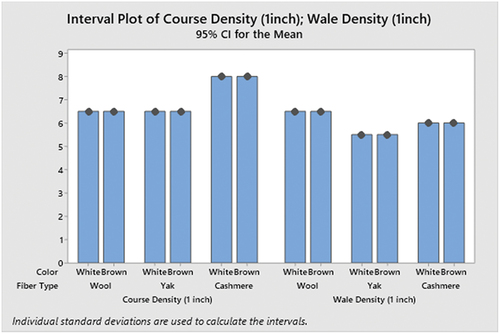
The thickness property of fabrics is an important property that influences the permeability characteristics and the handle of a fabric. The fabric thickness depends basically on the yarn count used for its production and the wale and course densities. The thickness and weight results of the fabrics are presented in . While the thickness of fabrics produced from brown wool and yak fibers was 5 mm, the thickness of fabrics produced from white wool and cashmere fibers was 3.5 mm. Yak fabric samples had the highest thickness values, which was not a coincidence since the yarns for knitting were thicker compared to others. The weight results of the fabrics were also found to be parallel with the results of the thickness results. Since the highest weight values belonged to the fabrics produced from yak fibers due to the thick yarns.
Derived values of fabric porosity properties are given in . This fabric property is useful to interpret the permeability of the fabrics when the fabrics have different yarn counts, course and wale densities, and fabric thicknesses.
Table 2. Porosity values of hand-knitted fabrics made of wool, yak, and cashmere fibers in two different colors.
In , CIEL*a*b*, and color yield (K/S) results of the fabrics produced from wool, yak and cashmere fibers are given. As the value of L* increases, it means that the color of the materials gets lighter. Among the fabrics produced from wool, yak and cashmere fibers in two different colors, the lightest color or in another way the whitest fabrics were produced from white wool, following white cashmere, white yak, brown cashmere, brown yak, and brown wool. These results are consistent with color yield values. Although all three fibers are brown, it can be said that the darkest color belongs to the wool fiber and is close to the yak fiber, while the cashmere fiber has a much lighter brown shade compared to them. When the color of the brown fibers is compared in terms of nuance, it is seen that the red hue of the color decreases in the order of yak → wool → cashmere (decreased a* value), while the yellow hue decreases in the order of yak → cashmere → wool (decreased b* value). Therefore, it can be said that there is not only a difference in darkness between the color of the fibers, but also a difference in nuance.
Figure 4. Ciel*a*b*, color yield, whiteness and yellowness index values fabrics produced from wool, yak, and cashmere fibers.
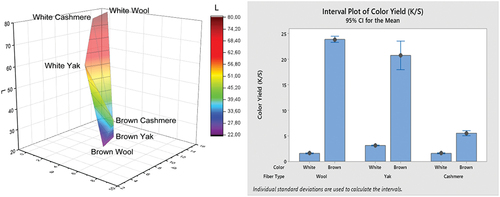
In , air permeability results of the fabrics are presented. Concerning the fabric air permeability (L/m2/sec), it was found that air permeability of the fabrics in descending order were white wool (1050) →white cashmere (850.33) →brown cashmere (697) →white yak (611.33) →brown wool (582.33) →brown yak (561.00). Based on the ANOVA analysis, the fiber type, fiber color, and their interaction had a significantly statistical effect on the air permeability properties of the produced fabrics (). While fabrics produced from wool and cashmere fibers had a high air permeability and classified in the same group with Tukey multiple comparisons, fabrics produced from yak fibers had the lowest air permeability results and were in different group. This result is expected since the yarn diameter of yak fibers were a little bit higher than those of the wool and cashmere fibers, and the weight and the thickness of the fabrics produced from yak fibers were higher compared to the other ones. In addition to yarn diameter, based on the calculated porosity values, there is a positive correlation between porosity and air permeability of the fabrics (
). As the porosity increased, the air permeability of the fabrics increased. When the effect of the fiber color was examined, there was an obvious difference between the results of the fabrics produced from white and brown fibers. Since the brown fibers were coarser than their equivalents regardless of fiber type and the yarns produced from these fibers were eventually coarser, which led to higher thickness values of fabrics and weights by using similar loop length in the fabric production. As a result, fiber fineness in fact influences the air permeability of the fabrics.
Figure 5. Fabric air permeability graphs regarding fiber type and fiber color a. Interval plot, b. main effects plot, and c. interaction plot.
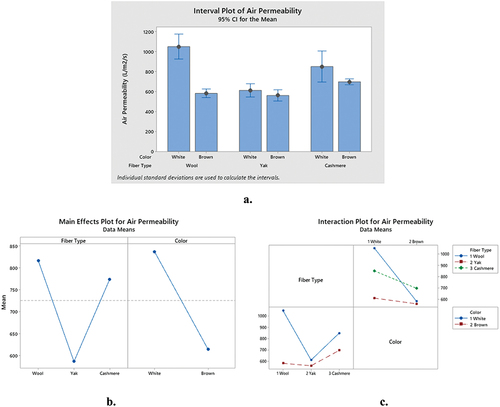
represents the results of the water vapor permeability, and the main effects of fiber type and fiber color and their interaction plots. The water vapor permeability properties of the fabrics were similar since all the fabrics were made of protein-based fibers consisting of many hydrophilic side chains like guanidine, amino, carboxyl, hydroxyl, amide, phenolic, etc., and peptide bonds of keratin fiber (Samanta et al. Citation2022). Even though neither fiber type nor fiber color on the water vapor permeability properties of fabrics had a significantly statistical effect on the water vapor permeability properties of fabrics (p > .05), the fabrics made of brown fibers had a lower permeability compared to the equivalent white fibers. As the fibers are protein-based, they have affinity to water and can absorb water till their 1/3 weight with a dry-feeling to the user. When the water vapor permeability results of fabrics are considered, the lowest values belonged to fabrics made of cashmere fibers following yak, and the highest values belonged to fabrics made of wool. Even though the fiber type did not have a significantly statistical effect on the water vapor permeability properties of fabrics, the fabrics made of brown fibers had a lower permeability compared to the equivalent white fibers. This is thought to be due to the fiber diameter. Since the white fibers were finer compared to the brown fibers, this resulted in higher porosity, and less thickness in fabrics in which finer yarns produced with finer fibers were used with similar wale and course densities. The porosity values of each fabric were also correlated with water vapor permeability results, and it was found that when the porosity of the fabrics increased, water vapor permeability of the fabrics increased which means there is a positive correlation ().
Figure 6. Fabric water vapor permeability graphs regarding fiber type and fiber color a. Interval plot, b. main effects plot, and c. interaction plot.
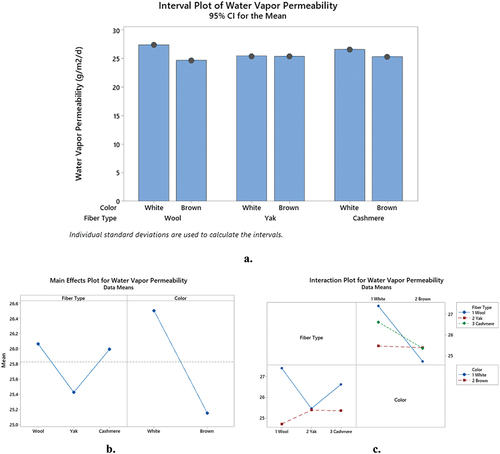
In , interval plots, main effects, and interaction plots for fabric handle regarding fiber type and fiber color are presented. Statistical analysis of the fabric handle showed that both fiber type and fiber color, and their interaction had a significant effect (). Concerning the fabric handle evaluating subjectively over a 10 grade point, it was found that fabric handle in descending order were brown cashmere (9.6) →white wool (8.5) →white cashmere (7.4) → white yak (5.0) → brown yak (3.5) →brown wool (2.0). Fiber type had a definite effect on the fabric handle. Based on Tukey multiple comparisons, three groups were formed, and the descending order according to fiber type was found to be fabrics made of cashmere, wool and yak fibers. Cashmere fibers are known to have a soft handle regardless of their diameter (Qin and Qu Citation2022). Therefore, fabrics made of cashmere fibers had the highest handle results. The small fiber friction coefficient is beneficial for improving the textile softness, but the cohesion force among fibers is also small, and does not benefit for yarn spinning (Qin and Qu Citation2022). For cashmere fibers, as the friction coefficient is not large, the fabrics made of these fibers have somehow a soft feeling. On the contrary, fabrics made of yak fibers had the stiffest handle following the fabrics made of brown wool. Fiber type had a significantly statistical effect; however, there was no obvious trend on the fabric handle. Fabrics made of brown cashmere fibers were the softest amongst, but the other fabrics made of brown fibers compared to their white equivalents were stiffer.
Conclusion
The properties of knitted fabrics made of yak and cashmere fibers were compared to the ones of the knitted fabrics made of wool fibers. The results led to the following conclusions.
Due to hand spinning and hand knitting processes, structural properties of the yarns and fabrics could not be strictly controlled during production, and this certainly affected the tested properties of the yarns and fabrics.
The hand-spun yarns made of yak fibers were coarser due to less fiber length and a thinner cuticle layer. On the other hand, wool fibers with higher fiber length and more prominent flake structure have higher fiber–fiber cohesion, so it was possible to spin relatively finer yarns. Cashmere yarns had the yarn count between yak and wool yarns due to its soft, short, and slippery scales.
The air permeability and water vapor permeability of the fabrics had a positive correlation with the related fabric porosities. If the porosity of the fabrics increased, the air permeability and water vapor permeability of the fabrics increased. The investigation of the air permeability properties of the fabrics made of yak and cashmere whether differ significantly, the air permeability of the fabrics made of cashmere yarns had higher air permeability values based on the high fabric porosity. But this doesn’t mean that the fabrics made of cashmere yarns have always better air permeability. By regulating the porosity of yak fabrics, air and water vapor permeability of these fabrics can be improved. The results of water vapor permeability were in parallel with air permeability results.
Finally, the handling properties of the fabrics were investigated and, as expected, fabrics made of cashmere fibers were the softest ones. Fabrics made of yak fibers had the stiffest handle following the fabrics made of brown wool. Fabrics made of brown cashmere fibers were the softest amongst them, but other fabrics made of brown fibers compared to their white equivalents were stiffer.
Highlights
The work titled “Determining the Permeability and Handle Properties Of Wool, Yak and Cashmere Hand-Knitted Fabrics” is about air and water vapor permeability properties of wool, yak and cashmere fibers which are important for consumer comfort were investigated in addition to handle properties of the fabrics compared with the properties of the fabrics made of wool fibers. The results can be summarized as follows:
Wool fibers were easy to spin in fine yarn counts whereas cashmere and yak fibers could be hand-spun in coarser yarn counts. This finding is similar to the previous studies. Since yak and cashmere fibers are delicate to spin in fine yarn counts. Besides fiber properties, pigmentation also affected the spinnability of a fiber.
The permeability properties of the fabrics were different from each other, however, there was no significant difference among them. The permeability of the fabrics was influenced mostly by porosity and high correlation coefficients were found.
Fabrics made of cashmere fibers had the softest feeling regardless of fabric specifications.
Cashmere and yak fibers are found in various colors in nature. There are not enough academic studies and published articles comparing the properties of the fabrics made of yak and cashmere fibers especially the effect of pigmentation on the fabric properties.
Ethical Approval
Ethical approval is not applicable, because this article does not contain any studies with human or animal subjects.
Acknowledgements
We would like to express our sincere thanks to the late Dr. Erhan ATAV, who supplied white and brown yak fibers from local farms during his touristic visit to Mongolia.
Disclosure statement
No potential conflict of interest was reported by the authors.
Additional information
Funding
References
- Angelow, A., H. Bednorz, S. Böttcher, N. Schrader, and A. Ehrmann. 2016. Optical differentiation between cashmere and other textile fibres by laser diffraction. Indian Journal of Fibre & Textile Research 41:444–14.
- Atav, R. 2009. Improvement of dyeing properties of some important protein fibers other than wool. İzmir: PhD Thesis, Ege Üniversitesi Fen Bilimleri Enstitüsü.
- Atav, R., U. Ergünay, and P. Gurkan Unal. 2022. Determining the effect of pigmentation on some physical and mechanical properties of yak and cashmere down fibers. Journal of Natural Fibers 20 (1). doi:10.1080/15440478.2022.2149939.
- n.d.a. Cashmere. Accessed March 2022. https://www.britannica.com/topic/cashmere.
- Das, P. J., J. Bam, V. Paul, D. Medhi, A. N. Roy, and S. M. Deb. 2017. The yak wool. Assam: SMJ Enterprise & Printers.
- Kim, Y., T. Kim, and H. M. Choi. 2013. Qualitative identification of cashmere and yak fibers by protein fingerprint analysis using matrix-assisted laser desorption/ionization time-of-flight mass spectrometry. Industrial & Engineering Chemistry Research 52 (16):5563–71. doi:10.1021/ie4003415.
- Li, L., G. Jia, and W. Zhou. 2009. Effect of yarn properties on the pilling of cashmere knitted fabric. Fibers & Textiles in Eastern Europe 17 (6):76–79.
- Liu, C., C. Xie, and X. Liu. 2018. Properties of yak wool in comparison to cashmere and camel hairs. Journal of Natural Fibers 15 (2):162–73. doi:10.1080/15440478.2016.1212762.
- Li, W., C. Xie, X. Su, X. Liu, Q. Liu, and C. Wei. 2016. Preparation and characterisation of high count yak wool yarns spun by complete compacting spinning and fabrics knitted from them. Fibers & Textiles in Eastern Europe 24 (1(115)):30–35. doi:10.5604/12303666.1172084.
- Li, L., and W. Zhou. 2006. Analysis on the pilling factors of cashmere knitted fabric. Fibers and Polymers 7 (2):213–16. doi:10.1007/BF02908269.
- Lu, W., J. Fei, J. Yang, M. Tang, Z. Dong, Z. Zhou, J. Ye, and H. Wu. 2013. A novel method to identify yak fiber in textile. Textile Research Journal 83 (8):773–79. doi:10.1177/0040517512460301.
- McGregor, B. A., and M. Naebe. 2016. Fabric handle properties of superfine wool fabrics with different fibre curvature, cashmere content and knitting tightness. The Journal of the Textile Institute 107:562–67. doi:10.1080/00405000.2015.1046310.
- McGregor, B. A., and R. Postle. 2004. Processing and quality of cashmere tops for ultrafine wool worsted blend fabrics. International Journal of Clothing Science and Technology 16 (1/2):119–31. doi:10.1108/09556220410520414.
- McGregor, B. A., and R. Postle. 2015. Mechanical properties of cashmere single jersey knitted fabrics blended with high and low crimp superfine merino wool. Textile Research Journal 78 (5):399–411. doi:10.1177/0040517507087675.
- Naebe, M., and B. A. McGregor. 2013. Comfort properties of superfine wool and wool/cashmere blend yarns and fabrics. The Journal of the Textile Institute 104 (6):634–40. doi:10.1080/00405000.2012.752560.
- Paolella, S., M. Bencivenni, F. Lambertini, B. Prandi, A. Faccini, C. Tonetti, C. Vineis, and S. Sforza. 2013. Identification and quantification of different species in animal fibres by LC/ESI-MS analysis of keratin-derived proteolytic peptides. Journal of Mass Spectrometry: JMS. 48 (8):919–29. 2013 Aug; 48. doi:10.1002/jms.3222.
- Qin, X., H. Liang, G. Wang, X. Su, and X. Liu. 2017. Research on knitted fabric properties of yak cashmere and cotton blend yarns. Fibers & Textiles in Eastern Europe; 25 (4(124)):31–35. doi:10.5604/01.3001.0010.2599.
- Qin, X., and L. Qu. 2022. Study on properties of yak cashmere fiber. International Journal of Clothing Science and Technology 34 (1):79–95. doi:10.1108/IJCST-06-2020-0096.
- Raja, A. S. M., D. B. Shakyawar, P. K. Pareek, and S. A. Wani. 2011. Production and Performance of pure cashmere shawl fabric using machine spun yarn by nylon dissolution process. Indian Journal of Small Ruminants 17 (2): 203–206.
- Samanta, K. K., A. N. Roy, S. Debnath, and H. Baite. 2022. Properties of natural and chemical modified yak keratin protein fibre and their application in insulation textile. Polymer Testing 111:107554. doi:10.1016/j.polymertesting.2022.107554.
- Vineis, C., A. Aluigi, and C. Tonin. 2011. Outstanding traits and thermal behaviour for the identification of speciality animal fibres. Textile Research Journal 81 (3):264–72. doi:10.1177/0040517510380779.
- Vineis, C., C. Tonetti, S. Paolella, P. Pozzo, and S. Sforza. 2014. A UPLC/ESI–MS method for identifying wool, cashmere and yak fibres. Textile Research Journal 84 (9):953–58. doi:10.1177/0040517513512394.
- n.d.b. Wool Fibre Properties. Accessed March 2022. https://www.sciencelearn.org.nz/resources/875-wool-fibre-properties.
- Xing, W., Y. Liu, B. Xin, L. Zang, and N. Deng. 2022. The application of deep and transfer learning for identifying cashmere and wool fibers. Journal of Natural Fibers 19 (1):88–104. doi:10.1080/15440478.2020.1727817.
- Xing, W., B. Xin, N. Deng, Y. Chen, and Z. Zhang. 2019. A novel digital analysis method for measuring and identifying of wool and cashmere fibers. Measurement 11–21. doi:10.1016/j.measurement.2018.09.032.
- Yan, K., H. Höcker, and K. Schaefer. 2000. Handle of bleached knitted fabric made from fine yak hair. Textile Research Journal 70 (8):734–38. doi:10.1177/004051750007000812.
- Yuan, S., K. Lu, and Y. Zhong. 2016. Identification of wool and cashmere based on texture analysis. Key Engineering Materials 671:385–90. doi:10.4028/0000www.scientific.net/KEM.671.385.
- Zoccola, M., N. Lu, R. Mossotti, R. Innocenti, and A. Montarsolo. 2013. Identification of wool, cashmere, yak, and angora rabbit fibers and quantitative determination of wool and cashmere in blend: A near infrared spectroscopy study. Fibers and Polymers 14 (8):1283–89. doi:10.1007/s12221-013-1283-0.

